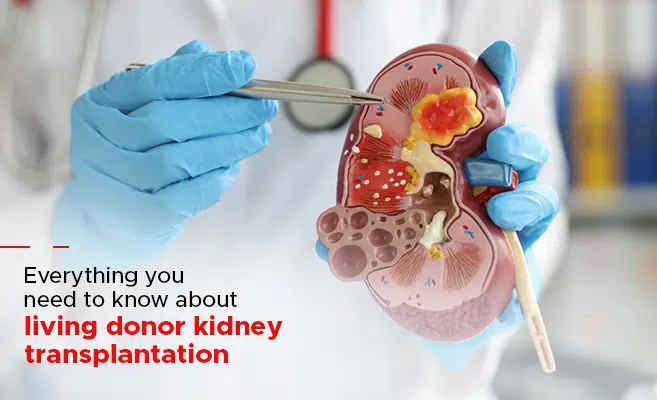What You Should Know About Living Donor Kidney Transplants

The kidneys are the small reddish-brown bean-shaped organs situated on either side of the spine, below the ribs, and behind the stomach. Each kidney varies from 4 to 5 inches, roughly the size of a fist. The main job of the kidney is to filter the blood besides removal of waste products, controlling the body’s fluid balance, and maintaining the electrolyte balance are other functions carried out by kidneys regularly.
Each kidney comprises millions of small tiny filtering units known as nephrons. They are structural and functional units of the kidney that help the kidney to carry out these filtration processes. The body’s blood is processed through the kidneys at least 40 times a day. When the blood enters the kidney, waste gets removed, and products like salt, water, and minerals are adjusted as needed.
The filtered blood is sent back to the body, and the water is converted into urine. All this urine is collected into a funnel-shaped organ known as the bladder. But what if these filtration units stop working? “Our body does not produce any urine a day, filtration of the blood does not take place, and waste products start accumulating in our body” This all leaves a major impact on a person’s health and is a major indicator of patient kidney malfunctioning. This is evident in patients suffering from end-stage renal diseases.
For their survival, the patient is left with only two cures. The short-term cure is dialysis and the ultimate and end-stage cure is kidney transplantation. A kidney transplant is basically of two types: a deceased donor or a living donor kidney transplant depending on the source of the organ being received. An organ transplant can be genetically related or non-related depending on whether the relationship between the donor and the recipient is biological or not. Let us know more about living donor kidney transplantation and how it is done.

A living donor kidney transplantation is a surgical procedure to remove an organ or portion of an organ from a healthy person and place it in another person whose organ is not functioning properly. In India, after the human organ transplantation act was passed in 1994, kidney transplantation started in a regulated manner. Since then, the popularity of living donor kidney transplantation has increased dramatically. Almost 7500 kidney transplants are performed at 250 kidney transplant hospitals in Delhi.
How is it done?
When a patient is diagnosed with end-stage renal disease, the patient has to undergo a thorough medical checkup. The donor can be anyone, a family member, friend, or relative willing to donate their kidney. But the prime requisite before any kidney transplantation is that the donor’s kidney matches the recipient’s. Then the kidney from the living donor is removed after all the medical checkups and placed into the recipient’s body. It’s never necessary for a person to have both kidneys for healthy living. One kidney can also provide a functioning renal system if the patient has a good lifestyle. Hence, a patient with two failed kidneys needs only one kidney to maintain a good quality of life.
Living organ donation types
There are two types of living organ donation. Living kidney donation can be directed donation or non-directed donation. When the donor directs the organ to a specific recipient suffering from end-stage kidney diseases. They can be anyone, a first-degree relative, a parent, a brother, a sister, or an adult child. Other biologically related persons such as uncles, aunts, or cousins. Another type of living donor kidney transplantation is a nondirected donation. In this, the donor may swap a kidney with another pair of donor & patient.
Living donor kidney transplants are a more preferred option by many patients and professionals. Better long-term results, no long waiting period, and surgery can be planned according to the patient’s and recipient’s convenience. There are significantly lower risks of complications or organ rejection after a living donor kidney transplantation. So, do not hesitate to give a kidney should someone in your immediate family suffers from kidney failure and need a kidney transplant.

 Book An Appointment
Book An Appointment Virtual Consultation
Virtual Consultation





